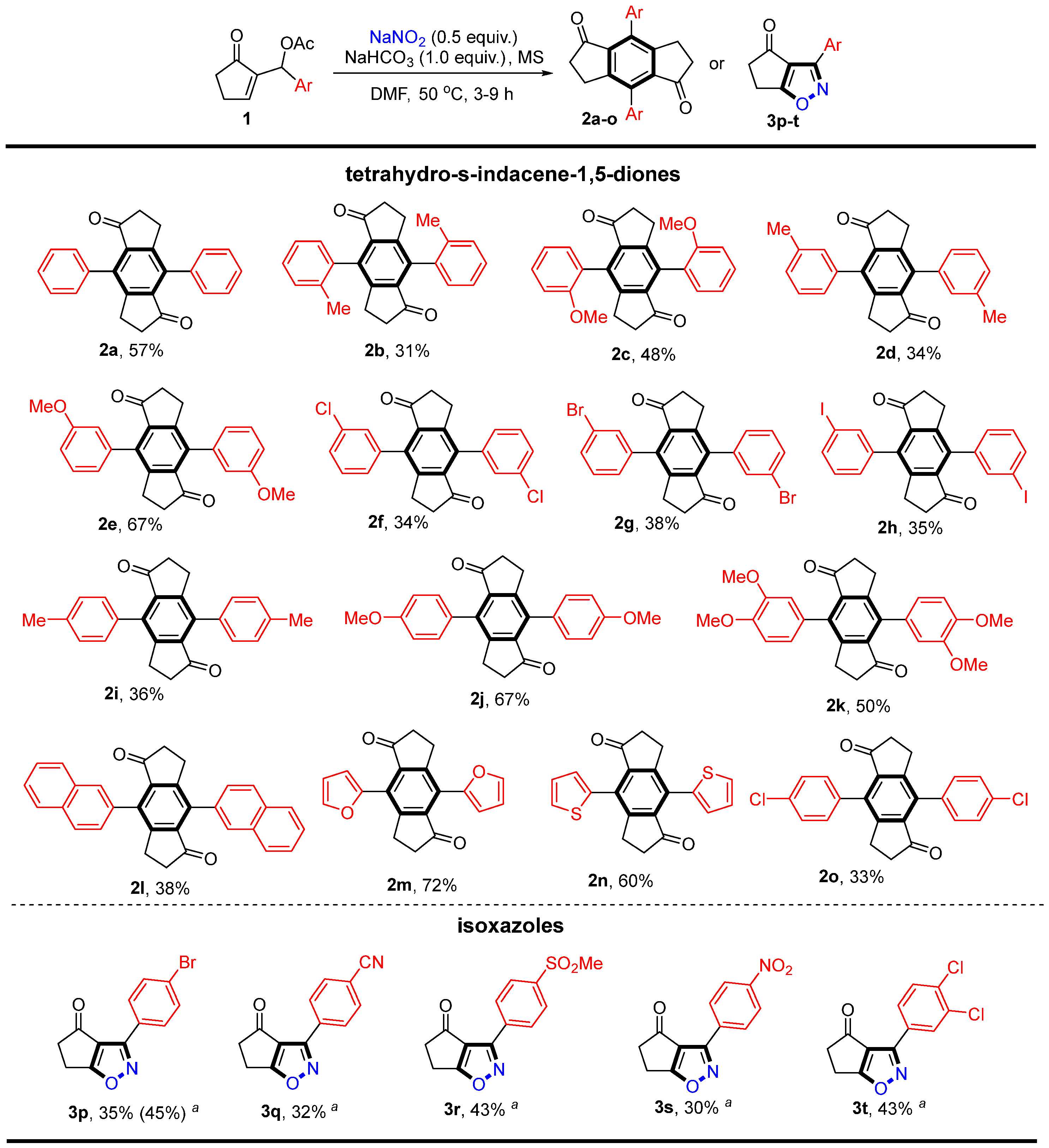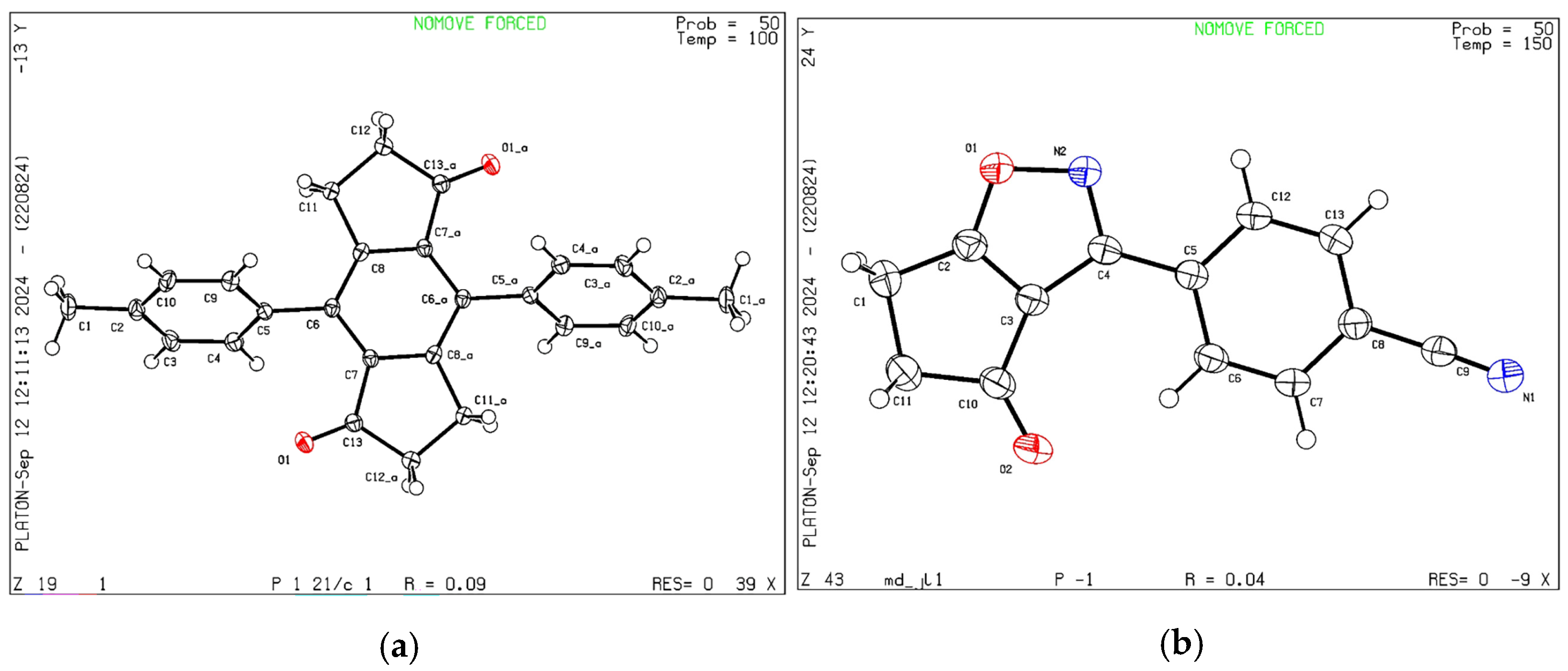Synthesis of Novel s-Indacene-1,5-dione and Isoxazole Derivatives via NaNO2-Catalyzed/Involved Transformation of Cyclopentenone-MBH Acetates
Abstract
1. Introduction
2. Results and Discussion
2.1. Optimization of Reaction Conditions
2.2. Substrates Scope
2.3. Hypothetical Mechanism
3. Materials and Methods
3.1. General Information
3.2. General Procedure for NaNO2-Catalyzed Synthesis of Tetrahydro-s-Indacene-1,5-diones
3.3. Characteristics of the Reaction Products 2a-o
3.4. General Procedure for NaNO2-Involved Synthesis of Cyclopentanone-Fused Isoxazoles
3.5. Characteristics of the Reaction Products 3p-t
4. Conclusions
Supplementary Materials
Author Contributions
Funding
Data Availability Statement
Conflicts of Interest
References
- Can, A.; Facchetti, A.; Usta, H. Indenofluorenes for organic optoelectronics: The dance of fused five-and six-membered rings enabling structural versatility. J. Mater. Chem. C 2022, 10, 8496–8535. [Google Scholar] [CrossRef]
- Jhang, S.-J.; Pandidurai, J.; Chu, C.-P.; Miyoshi, H.; Takahara, Y.; Miki, M.; Sotome, H.; Miyasaka, H.; Chatterjee, S.; Ozawa, R.; et al. s-indacene revisited: Modular synthesis and modulation of structures and molecular orbitals of hexaaryl derivatives. J. Am. Chem. Soc. 2023, 145, 4716–4729. [Google Scholar] [CrossRef]
- Dahrouch, M.; Diaz, E.; Gatica, N.; Moreno, Y.; Chavez, I.; Manriquez, J.M.; Rivière, P.; Rivière-Baudet, M.; Gornitzka, H.; Castel, A. Organogermanium polymers prepared from s-indacene and carbodiimide compounds. Appl. Organometal. Chem. 2012, 26, 410–416. [Google Scholar] [CrossRef]
- Shen, X.; Zheng, Y.; Wudl, F. Thermally induced reversible solid-state transformation of novel s-indacene 1,3,5,7-tetraone derivatives. J. Mater. Chem. C 2016, 4, 2427–2431. [Google Scholar] [CrossRef]
- Endo, Y.; Hasegawa, M.; Matsui, T.; Yagi, H.; Hino, S.; Mazaki, Y. Synthesis and electronic structure of dicyanofulvene-fused electron accepting molecule based on a 1,5-dihydro-s-indacene framework. Org. Lett. 2014, 16, 5608–5611. [Google Scholar] [CrossRef]
- Keuler, T.; Ferber, D.; Marleaux, M.; Geyer, M.; Gütschow, M. Structure–stability relationship of NLRP3 inflammasome-inhibiting sulfonylureas. ACS Omega 2022, 7, 8158–8162. [Google Scholar] [CrossRef] [PubMed]
- Dahrouch, M.R.; Jara, P.; Mendez, L.; Portilla, Y.; Abril, D.; Alfonso, G.; Chavez, I.; Manriquez, J.M. An effective and selective route to 1,5-dihydropolyalkylated s-indacenes: Characterization of their mono -and dianions by silylation. Structure of trans-1,5-bis(trimethylsilyl)-2,6-diethyl-4,8-dimethyl-s-indacene. Organometallics 2001, 20, 5591–5597. [Google Scholar] [CrossRef]
- Adams, C.; Araneda, J.; Morales, C.; Chavez, I.; Manriquez, J.M.; Carey, M.L.D.; Katir, N.; Castel, A.; Rivière, P.; Rivière-Baudet, M.; et al. Preparation and ESR characterization of polyalkyl-s-indacenyl anion-radicals from polyalkyl-1,5-dilithio-s-indacenes. Inorg. Chim. Acta 2011, 366, 44–52. [Google Scholar] [CrossRef]
- Reisch, H.; Wiesler, U.; Scherf, U.; Tuytuylkov, N. Poly (indenofluorene)(PIF), a novel low band gap polyhydrocarbon. Macromolecules 1996, 29, 8204–8210. [Google Scholar] [CrossRef]
- Tan, S.; Ma, H.; Liu, W.; Zhao, H.; Wu, Y.; Ba, X. Synthesis and characterization of conjugated polymers containing bifluorenylidenes units. Chem. J. Chin. U. 2014, 35, 1355–1362. [Google Scholar]
- Song, J.; Wei, F.; Sun, W.; Li, K.; Tian, Y.; Liu, C.; Li, Y.; Xie, L. Synthesis of fluoren-9-ones and ladder-type oligo-p-phenylene cores via Pd-catalyzed carbonylative multiple C–C bond formation. Org. Lett. 2015, 17, 2106–2109. [Google Scholar] [CrossRef] [PubMed]
- Takeuchi, R.; Yasue, H. Rhodium complex-catalyzed desilylative cyclocarbonylation of 1-aryl-2-(trimethylsilyl) acetylenes: A new route to 2,3-dihydro-1H-inden-1-ones. J. Org. Chem. 1993, 58, 5386–5392. [Google Scholar] [CrossRef]
- Padwa, A.; Chiacchio, U.; Fairfax, D.J.; Kassir, J.M.; Litrico, A.; Semones, M.A.; Xu, S.L. A comparative study of the decomposition of o-alkynyl-substituted aryl diazo ketones. Synthesis of polysubstituted β-naphthols via arylketene intermediates. J. Org. Chem. 1993, 58, 6429–6437. [Google Scholar] [CrossRef]
- Li, J.; Lin, Z.; Wu, W.; Jiang, H. Recent advances in metal catalyzed or mediated cyclization/functionalization of alkynes to construct isoxazoles. Org. Chem. Front. 2020, 7, 2325–2348. [Google Scholar] [CrossRef]
- Pandhurnekar, C.P.; Pandhurnekar, H.C.; Mungole, A.J.; Butoliya, S.S.; Yadao, B.G. A review of recent synthetic strategies and biological activities of isoxazole. J. Heterocycl. Chem. 2023, 60, 537–565. [Google Scholar] [CrossRef]
- Hu, F.; Szostak, M. Recent developments in the synthesis and reactivity of isoxazoles: Metal catalysis and beyond. Adv. Synth. Catal. 2015, 357, 2583–2614. [Google Scholar] [CrossRef]
- Das, S.; Chanda, K. An overview of metal-free synthetic routes to isoxazoles: The privileged scaffold. RSC Adv. 2021, 11, 32680–32705. [Google Scholar] [CrossRef] [PubMed]
- Feng, Q.; Huang, H.; Sun, J. Ru-catalyzed [3+2] cycloaddition of nitrile oxides and electron-rich alkynes with reversed regioselectivity. Org. Lett. 2021, 23, 2431–2436. [Google Scholar] [CrossRef] [PubMed]
- Carloni, L.-E.; Mohnani, S.; Bonifazi, D. Synthesis of 3,5-disubstituted isoxazoles through a 1,3-dipolar cycloaddition reaction between alkynes and nitrile oxides generated from O-silylated hydroxamic acids. Eur. J. Org. Chem. 2019, 2019, 7322–7334. [Google Scholar] [CrossRef]
- He, Y.; Wang, H.; Zhou, Y.; Yang, K.; Song, Q. Divergent synthesis of 5-and 4-(2,1-azaborine) substituted isoxazoles via regioselective [3 + 2] cycloadditions of nitrile oxides and B-ethynyl-1,2-azaborines. Org. Chem. Front. 2023, 10, 127–132. [Google Scholar] [CrossRef]
- Li, J.; Lin, Z.; He, D.; Lin, Z.; Zheng, Z.; Bi, C.; Wu, W.; Jiang, H. Palladium-catalyzed aerobic oxyarylthiolation of alkynone O-methyloximes with arylhydrazines and elemental sulfur. Org. Biomol. Chem. 2021, 19, 3396–3403. [Google Scholar] [CrossRef]
- Zhang, L.; Hong, C.; Tang, J.; Wu, W.; Jiang, H. Palladium-catalyzed carbohalogenation of olefins with alkynyl oxime ethers: Rapid access to chlorine-containing isoxazoles. J. Org. Chem. 2024, 89, 6615–6625. [Google Scholar] [CrossRef]
- Lai, Y.-L.; Yan, S.-X.; Zhang, S.-L.; Huang, Y.-H.; Hu, R.-X.; Chen, Y.-C.; Luo, J.-M.; Li, J. Palladium-catalyzed cascade cyclization/alkylation of oxime ethers: Assembly of 4-alkylisoxazoles by “chain-walking” strategy. Chem. Asian J. 2024, 17, e202200806. [Google Scholar] [CrossRef]
- Raghava, B.; Parameshwarappa, G.; Acharya, A.; Swaroop, T.R.; Rangappa, K.S.; Ila, H. Cyclocondensation of hydroxylamine with 1,3-bis(het)arylmonothio 1,3-diketones and 1,3-bis(het)aryl-3-(methylthio)-2-propenones: Synthesis of 3,5-bis(het)arylisoxazoles with complementary regioselectivity. Eur. J. Org. Chem. 2014, 2014, 1882–1892. [Google Scholar] [CrossRef]
- Silva, R.G.M.; da Silva, M.J.V.; Jacomini, A.P.; Moura, S.; Back, D.F.; Basso, E.A.; Rosa, F.A. Development of methodologies for the regioselective synthesis of four series of regioisomer isoxazoles from β-enamino diketones. RSC Adv. 2018, 8, 4773–4778. [Google Scholar] [CrossRef]
- Jiang, L.; Li, L.; Li, M.; Yuan, M.-W.; Yuan, M.-L. NaNO2-catalyzed reaction of cyclohexenone-MBH acetates: A convenient synthesis of 2-methylene-3-cyclohexenones. Synth. Commun. 2023, 53, 1520–1528. [Google Scholar] [CrossRef]
- Crystal Structure Data for the Structure of 2i and 3q Have Been Deposited with the Cambridge Crystallographic Data Centre as CCDC Reference Numbers 2383585 and 2383586, Respectively. These Data Can Be Obtained Free of Charge via. Available online: https://www.ccdc.cam.ac.uk/structures/ (accessed on 16 February 2025).
- Dighe, S.U.; Mukhopadhyay, S.; Kolle, S.; Kanojiya, S.; Batra, S. Synthesis of 3,4,5-trisubstituted isoxazoles from Morita–Baylis–Hillman acetates by an NaNO2/I2-mediated domino reaction. Angew. Chem. Int. Ed. 2015, 54, 10926–10930. [Google Scholar] [CrossRef] [PubMed]
- Mukhopadhyay, S.; Dighe, S.U.; Kolle, S.; Shukla, P.K.; Batra, S. NaNO2/I2-mediated regioselective synthesis of nitrosoimidazoheterocycles from acetophenones by a domino process. Eur. J. Org. Chem. 2016, 2016, 3836–3844. [Google Scholar] [CrossRef]
- Wang, X.; Liu, R.; Ding, Q.; Xiao, W.; Wu, J. Synergistic photoredox and tertiary amine catalysis: Generation of allylic sulfones from Morita–Baylis–Hillman acetates and sulfur dioxide. Org. Chem. Front. 2021, 8, 3308–3313. [Google Scholar] [CrossRef]






| Entry | Solvent | NaNO2 (equiv.) | Additive | Time (h) | Yield (%) b |
|---|---|---|---|---|---|
| 1 | DMF | 0.5 | / | 9 | 35 |
| 2 | DMSO | 0.5 | / | 9 | 28 |
| 3 | EtOH | 0.5 | / | 24 | N.R. |
| 4 | Toluene | 0.5 | / | 24 | N.R. |
| 5 | EtOH | 0.5 | / | 24 | N.R. |
| 6 | MeCN | 0.5 | / | 24 | N.R. |
| 7 | DMF | 0.5 | K2CO3 | 8 | 42 |
| 8 | DMF | 0.5 | NaHCO3 | 9 | 52 |
| 9 | DMF | 0.5 | LiBF4 | 9 | 38 |
| 10 | DMF | 0.5 | NaHCO3/MS | 9 | 57 |
| 11 | DMF | 0.6 | NaHCO3/MS | 6 | 51 |
| 12 | DMF | 0.4 | NaHCO3/MS | 9 | 48 |
| 13 c | DMF | 0.5 | NaHCO3/MS | 10 | 56 |
| 14 d | DMF | 0.5 | NaHCO3/MS | 12 | 40 |
| 15 e | DMF | 0.5 | NaHCO3/MS | 9 | 48 |
Disclaimer/Publisher’s Note: The statements, opinions and data contained in all publications are solely those of the individual author(s) and contributor(s) and not of MDPI and/or the editor(s). MDPI and/or the editor(s) disclaim responsibility for any injury to people or property resulting from any ideas, methods, instructions or products referred to in the content. |
© 2025 by the authors. Licensee MDPI, Basel, Switzerland. This article is an open access article distributed under the terms and conditions of the Creative Commons Attribution (CC BY) license (https://creativecommons.org/licenses/by/4.0/).
Share and Cite
Li, N.; Mo, X.-T.; Li, M.; Ma, Y.-N.; Jiang, L. Synthesis of Novel s-Indacene-1,5-dione and Isoxazole Derivatives via NaNO2-Catalyzed/Involved Transformation of Cyclopentenone-MBH Acetates. Catalysts 2025, 15, 186. https://doi.org/10.3390/catal15020186
Li N, Mo X-T, Li M, Ma Y-N, Jiang L. Synthesis of Novel s-Indacene-1,5-dione and Isoxazole Derivatives via NaNO2-Catalyzed/Involved Transformation of Cyclopentenone-MBH Acetates. Catalysts. 2025; 15(2):186. https://doi.org/10.3390/catal15020186
Chicago/Turabian StyleLi, Na, Xiao-Tian Mo, Min Li, Yi-Na Ma, and Lin Jiang. 2025. "Synthesis of Novel s-Indacene-1,5-dione and Isoxazole Derivatives via NaNO2-Catalyzed/Involved Transformation of Cyclopentenone-MBH Acetates" Catalysts 15, no. 2: 186. https://doi.org/10.3390/catal15020186
APA StyleLi, N., Mo, X.-T., Li, M., Ma, Y.-N., & Jiang, L. (2025). Synthesis of Novel s-Indacene-1,5-dione and Isoxazole Derivatives via NaNO2-Catalyzed/Involved Transformation of Cyclopentenone-MBH Acetates. Catalysts, 15(2), 186. https://doi.org/10.3390/catal15020186






